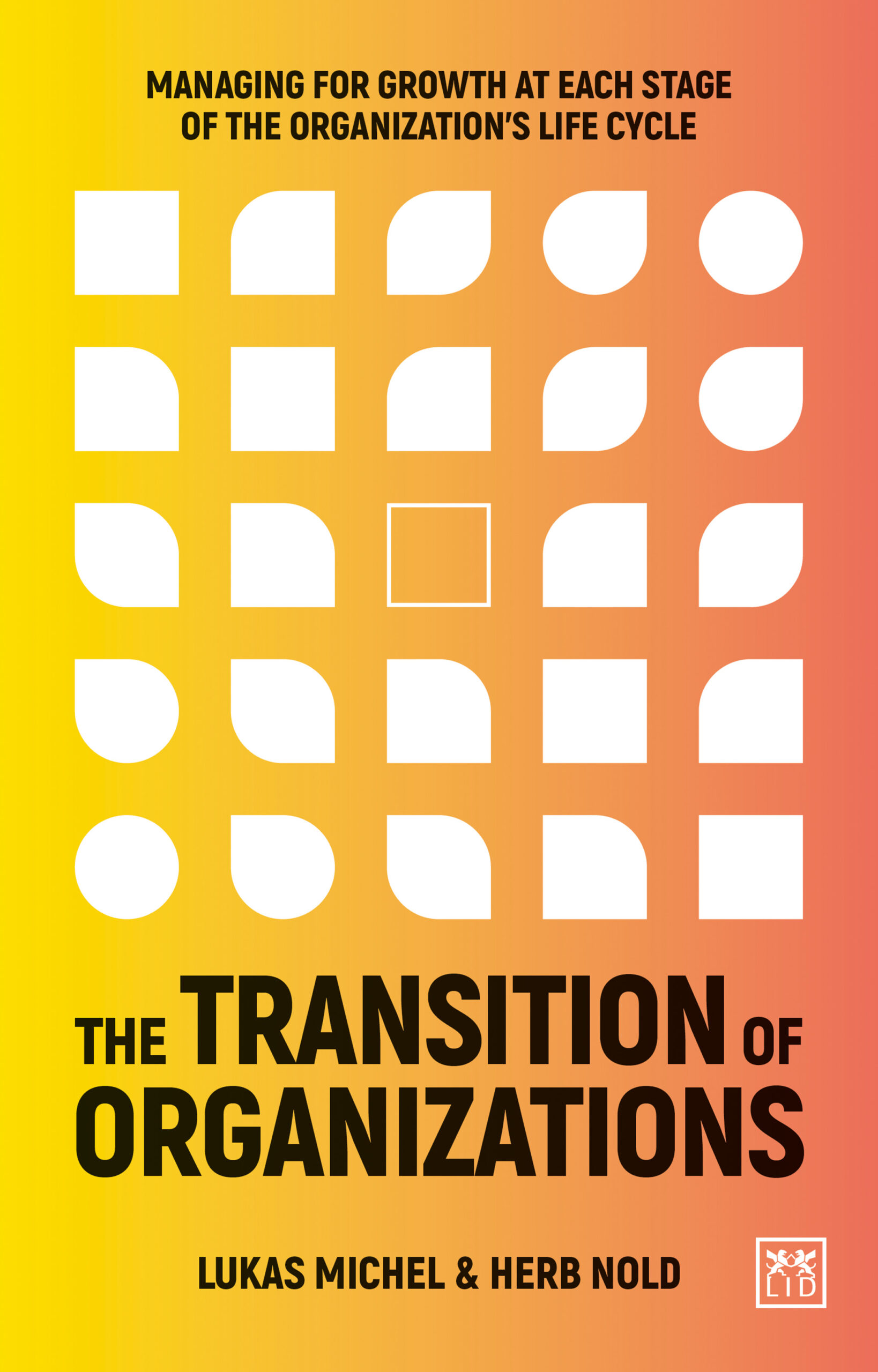|
Solving the Crisis of Control with Lukas Michel & Herb Nold
Solving the Crisis of Control

By Guest Contributors Lukas Michel & Herb Nold
Authors of The Transition of Organizations, Lukas Michel and Herb Nold, share how leaders can solve the crisis of control as their company enters its third life cycle stage.
The Transition of Organizations is the result of 20 years of work with clients around the globe and the related research that enabled us to conclude that there are patterns of deliberate strategies companies can follow to overcome their inherent structural crises.
Organizational growth follows five life cycle stages: creativity, direction, delegation, coordination, and collaboration. Every stage comes with specific evolutionary and revolutionary attributes, followed by a crisis or organizational challenge that must be overcome to advance to the next stage. We evaluate organizations by looking at their structure through the lens of viewing management as a competitive advantage. Mapping management patterns using the Leadership Scorecard tool allows us to identify the dominant management style for each life cycle stage.
More on the GROWTH LIFE CYCLES
The delegation stage. As organizations overcome the crisis of autonomy and emerge from the direction stage, decentralized structures with delegated decision-making and accountability are established. Professional managers are assigned to sub-units, plants, market areas or geographic territories and given expanded decision-making responsibility, with processes in place to hold them accountable to the home office. Trouble arises when top management at the headquarters level feel they lose control. This is the beginning of the crisis of control. Dynamic operations solve the crisis of control. Their tasks is to build coordination capabilities.
The decentralized organisation. To restore responsiveness and growth, the authority to make key decisions must be pushed to lower levels, where managers are closer to the customers and issues. Creating decentralized structures and delegating important decision-making responsibility closer to street level reduces the need to run routine decisions up the chain of command. In this way, the organization can be responsive to customers’ needs. In many companies, profit centre managers in market-based business units are given wide discretionary authority. They are held accountable for the profitability and performance of their unit. They typically have the freedom to run their own business, to meet local needs and expectations. This type of organization is particularly important to businesses trying to expand into new countries with unique cultures, demographics, and resources. Business unit or profit centre managers become responsible for setting strategy, staffing, and acquiring assets to support local product development, production, marketing and sales. Empowered profit centre leaders enable the organization to respond quickly and effectively to local market needs, restoring flexibility and improving responsiveness.
Crisis of control. To maintain sophisticated controls, a variety of specialized corporate support functions are installed. The purpose of these is to govern delegation by setting the rules of engagement for decentralized structures, and then monitoring the decisions to be sure that the rules are being followed. For example, HR establishes common risk-reducing policies and performance management strategies, finance/accounting drives profit and performance measurement, strategists develop and maintain a unified planning system, and corporate governance prescribes the boundaries. The CEO’s support staff coordinates the management system through a corporate cycle and calendar.
However, growth through delegation creates its own problems. Decentralized structures too often become independent fiefdoms whose unit managers are protected from the oversight of the head office. When this happens, coordination suffers, resources are wasted and profitability declines, leading to a crisis of control.
Dynamic operations. The third transition is the move from the delegation stage to the coordination stage of growth. The crisis of control emerges at the delegation stage, which inhibits continued growth to the coordination state. The task at this point is to adopt a change-based mode of operation guided by the components of the Leadership Scorecard. Developing dynamic capabilities becomes essential to successfully support managers with delegated responsibility and accountability of segment-type units.
Solving the crisis of control. Transitioning from a decentralized to a segmented organization requires change-based management supported by a dynamic operating system. Dynamic systems are the most effective choices for an emergent, self-organized and delegated environment. Armed with these tools, managers are able to coordinate activities through interactive leadership and a shared culture that generates intangible value.
The different management modes describe bundles of managerial principles and capabilities that characterize operations in stable or dynamic environments. Dynamic operating systems are a feature of better management. Such systems enable the organization to deal with a VUCA environment and limit the risks by preventing people from taking short-cuts, which undermine the operating system and create an infected culture.
To solve the crisis of control of decentralized units, better management principles require a dynamic operating system as the pre-condition for the coordination of segment organizations. Dynamic operating systems differentiate from traditional systems that work in a stable context through a choice of four levers.
The change-based mode of operating is the best solution in a segmented organization where coordination is essential and the environment is dynamic. Top management must be able to quickly alter structures to serve the needs of a specific segment and stick to the growth plan as opportunities or threats appear and disappear.
For organizations in a dynamic market environment with centralized decision-making, direct intervention by senior executives in the change mode becomes the dominant management style. Dynamic systems (the means) meet traditional ways to lead people (the ends).
Organizations in the change mode operate and adjust to market conditions in response to opportunities or threats. Managers alter the resource base, align interests through incentives and restructure accountabilities in response to market changes to increase responsiveness.
Building coordination capabilities. A dynamic operating system serves as the means for top management to control operations through diagnostic systems, interactive leadership, and shared culture, with intangible capabilities as keys to success. Once implemented, the dynamic operating system works like a compass for the entire organization.
These five components of diagnostic systems function as controls to guide people on what needs to get done. Engage your team by answering the following questions:
- Information: What is going on? Are you getting the right information to the team needed to make an informed decision?
- Strategy: What game are you playing? Does everyone on the team know the strategy and have they bought into it?
- Implementation: How do you succeed? Does everyone on the team know what needs to be done to be successful and what their role is?
- Beliefs: What are the shared and individual ambitions of the team and it’s members? Do people on the team aspire to reach similar objectives?
- Boundaries: Where are the limits? Do team members recognize the limits of their authority and responsibilities?
In successful companies in a dynamic environment, self-responsible people with delegated authority and knowledge respond to customer needs or threats. Managers effectively communicate where the company is trying to go, and then trust employees to make the best choice on how to get there. The organizational energy is well aligned, with the right capabilities in place to give individuals and segments the tools to act quickly and effectively. Self-responsibility drives motivation, and shared values and norms keep everyone within the boundaries.
Coordination resolves the crisis of control that inhibits coordination. Efficient transition from the delegation stage to the coordination stage requires dynamic systems with change-based management principles. Better management operating systems resolve the tension between dynamic capabilities and the red-tape crisis.
Decentralized organizations delegate accountability to managers of sub-units, plants, markets, or geographies. This independence and freedom to act encourages unit managers to employ people-centric methodologies and improves responsiveness to the customer or market. Business unit managers develop and implement processes and systems to measure performance and report to headquarters. Top management at the home office begins to sense a loss of effective oversight, and the crisis of control has arrived. Further growth comes from dynamic operations that establish better coordination capabilities.
What can you do?
- Coordinate activities through a dynamic operating system.
- Review your organization’s coordination capabilities.
- Answer the Leadership Scorecard questions with your team.
- Activate a change-based management mode.
- Manage powerful segments through diagnostic systems, interactive leadership, and a shared culture.
- Pay close attention to the intangibles of culture and success.
Key words: delegation – the decentralized organisation – crisis of control – dynamic operations (solving the crisis of control), building coordination capabilities.
————————————————————————————————————————————————
Bibliography: Greiner, L. E. (1998). Evolution and Revolution as Organizations Grow. Harvard Business Review: Mai-June.
ABOUT THE AUTHOR

Suggested Reading
 The Transition of Organizations explores various common patterns of management styles and then offers transition strategies to help managers succeed in the digital economy. The authors guide leaders to prepare for these transitions by laying the foundations or infrastructure needed to prevent a crisis that inhibits further growth. They also provide leaders with a greater understanding of the growth framework, which will help leaders to manage better the development of their companies.
The Transition of Organizations explores various common patterns of management styles and then offers transition strategies to help managers succeed in the digital economy. The authors guide leaders to prepare for these transitions by laying the foundations or infrastructure needed to prevent a crisis that inhibits further growth. They also provide leaders with a greater understanding of the growth framework, which will help leaders to manage better the development of their companies.

